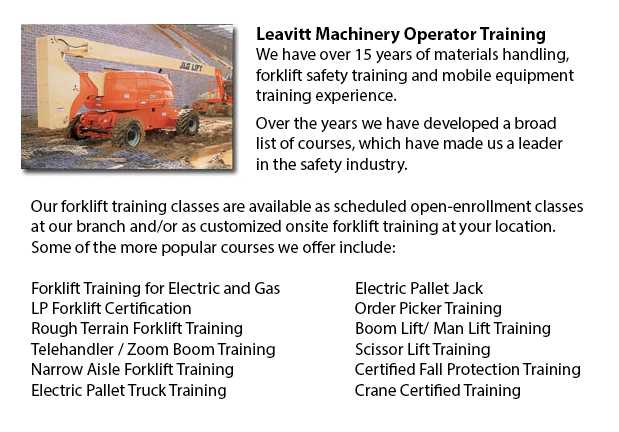
Hamilton Boom Lift Safey Training - Boom lifts are a type of elevated work platform or aerial lifting device which are normally used in construction, industry, and warehousing. Boom lifts could be utilized in virtually any environment due to their versatility.
Elevated work platforms allow personnel to get into work places that will be inaccessible otherwise. There is inherent risk in the operation of these devices. Employees who operate them must be trained in the right operating methods. Accident prevention is vital.
Boom Lift Training Programs include the safety factors involved in boom lift operation. The program is best for individuals who operate self-propelled boom supported elevated work platforms and self-propelled elevated work platforms. Upon successful completion of the course, participants will be issued a certificate by somebody licensed to verify completing a hands-on evaluation.
Industry agencies, local and federal regulators, and lift manufacturers all play a part in providing information and establishing standards in order to help train operators in the safe use of elevated work platforms. The most important ways in preventing accidents associated to the utilization of elevated work platforms are as follows: having on safety gear, performing site assessment and checking machines.
Important safety considerations when operating Boom lifts:
Operators must observe the minimum safe approach distance (or also called MSAD) from power lines. Voltage could arc across the air to find an easy path to ground.
So as to maintain stability as the platform nears the ground, a telescopic boom needs to be retracted prior to lowering a work platform.
People working from the platform of a Boom lift must tie off to guarantee their safety. Safety harness and lanyard combinations should not be attached to any anchorage other than that provided by the manufacturer, never to other poles or wires. Tying off may or may not be required in scissor lifts, depending on specific local regulations, employer guidelines or job risks.
Avoid working on a slope which goes beyond the maximum slope rating as specified by the manufacturer. If the slop goes beyond requirements, then the equipment should be transported or winched over the slope. A grade can be simply measured by laying a straight edge or board of at least 3 feet on the slope. After that a carpenter's level can be laid on the straight edge and raising the end until it is level. The percent slope is attained by measuring the distance to the ground (likewise referred to as the rise) and then dividing the rise by the length of the straight edge. Afterward multiply by 100.
-
Hamilton Aerial Platform Training
Hamilton Aerial Platform Training - Aerial hoists are able to accommodate various odd jobs involving high and hard reaching spaces. Often utilized to perform routine repair in structures with high ceilings, prune tree branches, hoist heavy shelving u... More -
Hamilton Heavy Equipment Operator Certification
Hamilton Heavy Equipment Operator Certification - The heavy equipment operator is a person who manipulates the controls and drives different kinds of big machinery. Heavy machinery is most commonly utilized on construction sites to deliver supplies t... More -
Hamilton Scissor Lift Ticket
Hamilton Scissor Lift Ticket - Scissor lifts have greatly benefited construction operations in view of the fact that the job that used to require much effort and lots of people, can now be completed utilizing the scissor lift truck and only one indiv... More -
Hamilton Forklift Certification Courses
Hamilton Forklift Certification Courses - Forklift certification courses really help to make sure that businesses utilizing forklifts, comply with the regional and local rules. The drivers of the forklift should undergo forklift certification prior t... More -
Hamilton Forklift Training Program
Hamilton Forklift Training Program - The forklift is a common powered industrial vehicle which is in wide use these days. They are occasionally called jitneys, hi los or lift trucks. A departments store would use the forklift to unload and load merch... More -
Hamilton Forklift License
Hamilton Forklift License - Obtaining a forklift license or forklift certification in North America would require the trainee to do hands-on training in addition to classroom instruction. The state, provincial and federal regulatory bodies are respon... More -
Hamilton Manlift Operator Certification
Hamilton Manlift Operator Certification - Our aerial lift and scissor platform training and certification empowers participants with a general understanding and knowledge of the efficient and safe use of "Power Operated Mobile Work Platforms," under... More -
Hamilton Forklift Operator Certification
Hamilton Forklift Operator Certification - Forklift operator certification is usually needed for employees working in industrial, warehouse or construction setting to guarantee the safe utilization of forklifts. Workplace training has to follow a met... More

Forklift Certification Hamilton
TOLL FREE: 1-888-254-6157
Hamilton, Ontario
forkliftcertificationhamilton.com
Email Us
About Us


